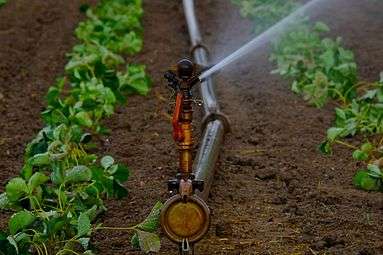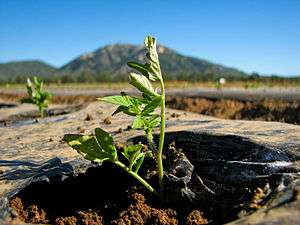Farm water

Farm water, also known as agricultural water, is water committed for use in the production of food and fiber. On average, 80 percent of the fresh water withdrawn from rivers and groundwater is used to produce food and other agricultural products.[1] Farm water may include water used in the irrigation of crops or the watering of livestock.
Water is one of the most fundamental parts of the global economy. It has been shown, that in areas without healthy water resources or sanitation services that economic growth cannot be sustained.[2] Without access to clean water, nearly every industry would suffer, most notably, would be agriculture. As water scarcity grows as a global concern, food security is also brought into consideration. A recent example of this could be the drought in California—it is projected that for every $100 spent on foods from this state, a consumer should expect to pay up to $15 additionally.[3]
Livestock Water Use
Livestock and meat production have one of the largest water footprints of the agricultural industry. Taking nearly 1,800 gallons of water to produce one pound of beef and 576 gallons for pork. For reference, it only takes about 108 gallons of water to harvest one pound of corn.[4] Livestock production is also one of the most resource intensive agricultural outputs. This is largely due to their large feed conversion ratio. Livestock's large water consumption may also be attributed to the amount of time it takes to raise an animal to slaughter. Again, in contrast to corn, which grows to maturity in about 100 days. This adds an extra 995 days of water to grow cattle. The global "food animal" population is just over 20 billion creatures, with 7+ billion humans, this equates to about 2.85 animals per human.[4]
Cattle
The beef and dairy industries are the most lucrative branches of the U.S. agricultural industry, however, they are also the most resource intensive. To date, beef is the most popular of the meats; the U.S. alone produced 25.8 billion pounds in 2013.[4] In this same year, 201.2 billion pounds of milk were produced.[5] These cattle are mostly raised in centralized animal feeding operations, or CAFOs. On average, a mature cow will consume anywhere from seven to twenty-four gallons of water a day; cows that are lactating require about twice as much water.[6] The amount of water that cattle may drink in a day also depends upon the temperature.[7]
Cattle have a feed conversion ratio of 6:1, for every six pounds of food consumed, the animal should gain one pound.[8] Thus, there is also a substantial "indirect" need for water in order to grow the feed for the livestock. Growing the amount of feed grains necessary for raising livestock accounts for 56 percent of the U.S water consumption.[9] Of a 1,000 pound cow, only 430 pounds make it to the retail markets.[10] This 18 percent loss, creates an even greater demand for cattle, being that CAFOs must make up for this lost profitable weight, by increasing the amount of cows that they raise.
Water scarcity is not necessarily a new issue, however, cattle ranchers in America have been cutting heard sizes since the 1950s in efforts to curb water and manufacturing costs. This shift has led to more efficient feeding and health methods, allowing ranchers to harvest more beef per animal.[11] The rising popularity of these CAFOs are creating a larger demand for water, however. Grass-fed or grazing cows consume about twelve percent more water through the ingestion of live plants, than those cows who are fed dried grains.[12]
Poultry and Fowl
Water is one of the most crucial aspects of poultry raising, as they use this to carry food through their system, and assist in digestion. Additionally, farmers monitor flock water consumption to measure the overall health of their birds. As birds grow older they should be consuming more feed and about three times as much water.[13] In just three weeks a bird's water consumption should increase by about 10 gallons a day.[13] Water consumption is also influenced by temperature. When it is hot outside bird will pant to keep cool, thus losing much of their water.[14] A study based in Ohio showed that 67 percent of water sampled near poultry farms contained antibiotics.[15]
Horticulture Water Use

With modern advancements, crops are being cultivated year round in countries all around the world. As water usage becomes a more pervasive global issue, irrigation practices for crops are being refined and becoming more sustainable. While there are a variety of irrigation systems, these may be grouped into two types: high flow and low flow. These systems must be managed precisely to prevent runoff, over spray, or low-head drainage.[16]
Scarcity of Water in Agriculture
50 years ago, the common perception was that water was an infinite resource. At this time, there were fewer than half the current number of people on the planet. Affluence was not as high, individuals consumed fewer calories and ate less meat, so less water was needed to produce their food. They required a third of the volume of water we presently take from rivers. Today, the competition for water resources is much more intense. This is because there are now nearly eight billion people on the planet, their consumption of meat and vegetables is rising. Competition for water from industry, urbanisation and biofuel crops is rising congruently. To avoid a global water crisis, farmers will have to make strides to increase productivity to meet growing demands for food, while industry and cities find ways to use water more efficiently.[17]
Successful agriculture is dependent upon farmers having sufficient access to water. However, water scarcity is already a critical constraint to farming in many parts of the world. Physical water scarcity is where there is not enough water to meet all demands, including that needed for ecosystems to function effectively. Arid regions frequently suffer from physical water scarcity. It also occurs where water seems abundant but where resources are over-committed. This can happen where there is over development of hydraulic infrastructure, usually for irrigation. Symptoms of physical water scarcity include environmental degradation and declining groundwater. Economic scarcity, meanwhile, is caused by a lack of investment in water or insufficient human capacity to satisfy the demand for water. Symptoms of economic water scarcity include a lack of infrastructure, with people often having to fetch water from rivers for domestic and agricultural uses. Some 2.8 billion people currently live in water-scarce areas.[18]
Sustainable Water Use

While it is evident that water use affects environmental degradation and economic growth, it is also sparking innovation regarding new irrigation methods. In 2006, the USDA predicted that if the agricultural sector improved water efficiency by just 10 percent farms could annually save upwards of $200 million per year.[19] Many of the practices which cut water use are cost effective. Farmers who use straw, compost, or mulch around their crops will reduce evaporation by about 75 percent.[20] This would also reduce the number of weeds and save a farmer from using herbicides. Mulches or ground covers also allow the soils to absorb more water by reducing compaction. The use of white or pale gravel is also practiced, as it reduces evaporation and keeps soil temperatures low by reflecting sunlight.
In addition to reducing water loss at the sink, there are also more sustainable ways to harvest water. Many modern small (non industrial) farmers are using rain barrels to collect the water needed for their crops and livestock. On average, rainwater harvesting reduces the cost of water per cubic meter in half.[21] This would also greatly reduce the stress on local aquifers and wells. Because farmers use the roofs of their buildings to gather this water, this also reduced rainwater runoff and soil erosion on and around their farm.
References
- ↑ "USDA Economic Research Service - Irrigation & Water Use". www.ers.usda.gov. Retrieved 2015-11-17.
- ↑ "Water Scarcity: Economic Implications | Water Resource | Water Economy". Growing Blue. Retrieved 2015-11-17.
- ↑ "Water crisis in California to drive up food prices". ABC10. Retrieved 2015-11-17.
- 1 2 3 "Meat’s large water footprint: why raising livestock and poultry for meat is so resource-intensive". Food Tank. Retrieved 2015-11-17.
- ↑ http://www.fmmacentral.com/PDFdata/msb201402.pdf
- ↑ http://beef.unl.edu/amountwatercowsdrink
- ↑ "Water Availability and Distribution for Livestock". www.noble.org. Retrieved 2015-11-17.
- ↑ "Cattlemen's College: Cattle Feed Efficiency". Agriculture Proud. Retrieved 2015-11-17.
- ↑ http://www.cspinet.org/EatingGreen/pdf/arguments4.pdf
- ↑ http://www.oda.state.ok.us/food/fs-cowweight.pdf
- ↑ "Beef and Water Use: Has the Drought had an Impact?". Facts About Beef. Retrieved 2015-11-17.
- ↑ ftp://ftp.fao.org/docrep/fao/010/a0701e/a0701e04.pdf
- 1 2 "Broiler Water Consumption". The Poultry Site. Retrieved 2015-12-11.
- ↑ "Poultry Drinking Water Primer | Publications | UGA Extension". extension.uga.edu. Retrieved 2015-12-11.
- ↑ Campagnolo, E.R., Kammy, R., Johnson, A.K., Rubin C.S., Kolpin, D.W., Meyer, M.T., Esteban, E.J., Currier, R.W., Smith, K., Thu, K.M., & McGeehin, M. (2002). Antimicrobial residues in animal waste and water resources proximal to large-scale swine and poultry feeding operations. The Science of the Total Environment.
- ↑ "Types of Irrigation Systems". togetherweconservelandscape.com. Retrieved 2015-11-17.
- ↑ Chartres, C. and Varma, S. Out of water. From Abundance to Scarcity and How to Solve the World’s Water Problems FT Press (USA), 2010
- ↑ Molden, D. (Ed). Water for food, Water for life: A Comprehensive Assessment of Water Management in Agriculture. Earthscan/IWMI, 2007.
- ↑ USDA Natural Resources Conservation Service. (2006). Energy Management. Conservation Resource Brief.
- ↑ "Prevent weeds, improve soil and save water by mulching your garden | Oregon State University Extension Service | Gardening". extension.oregonstate.edu. Retrieved 2015-12-11.
- ↑ "Agricultural Rainwater Harvesting". oasis-rainharvesting.co.uk. Retrieved 2015-12-11.